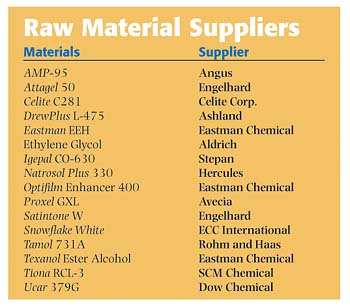Recently, increasingly stringent environmental regulations have required changes in how latex paints used in architectural applications are formulated. A variety of formulating methods and new raw materials have been developed to help paint manufacturers meet the new regulations. Now formulators can meet VOC regulations while maintaining performance properties in architectural coatings. The following provides an overview of formulation techniques to help balance performance and regulatory compliance in latex paints for architectural applications.

Regulatory Issues
Paint formulators in certain U.S. regions struggle to achieve the correct balance between meeting today's stringent VOC requirements while maintaining the performance properties of architectural coatings. The two main additives that add VOC to a latex paint are antifreeze/open-time additives (i.e., ethylene and propylene glycol) and coalescents. Conventional coalescents add VOC, but mixing and matching with other types of coalescents can actually reduce the VOC of latex paints.
Coalescents
Architectural latex paints are made from a variety of different polymers that are selected based on performance requirements and cost. The monomers used in these polymers determine the glass transition temperature (Tg), which characterizes the hardness of the final polymer at a given temperature. The Tg and polymer type influence the amount and type of solvent required to coalesce the polymer. Substrate, application, dry time, compatibility, VOC regulations, and efficiency all play a role in determining the type of solvent or combination of solvents to be used.
A conventional coalescent temporarily lowers the Tg, providing mobility to the polymer chains. The softened polymer can then flow and fuse with other polymer chains in the system, creating a protective, decorative film. To be effective, the coalescent has to remain in the film after the water has evaporated to ensure that a homogeneous film develops. A conventional coalescent will evaporate out of the film after a period of time and the film will regain its initial Tg and hardness. Various coalescents can be used individually or in combination to help formulators optimize performance in architectural coatings, while meeting VOC regulations.
Formulating Options
Glycol Removal
There are many options for formulators striving to meet VOC requirements. One way, for example, is glycol removal. In a typical latex paint, the largest contributor to VOC comes from glycol, added for freeze/thaw stability and increased open-time. It is normally present at levels two to three times the amount of the coalescent. In most cases, formulators could meet VOC requirements by simply leaving out the glycol, but this can lead to problems in colder climates, where freezing can occur, and in paints where open-time is important.
Use of a Lower Tg Latex
Another method is to use a lower Tg latex, which requires little to no solvent to form a film. However, these latexes generally have limited formulation latitude. This option requires the formulator to reformulate and test the paint, which can be time-consuming and expensive. In addition, these polymers are inherently soft and remain soft throughout the life of the paint, never regaining hardness like conventional latexes that have been coalesced to form a film. In addition, these low-Tg latexes are susceptible to freezing unless formulated with glycol.Use of Non-Fugitive or Reactive Coalescents
An additional option is to replace some of the conventional solvents used in latex paints with a higher boiling film former, which is either non- or partially fugitive. Recently, non-fugitive film formers have been advertised to help companies formulate low-VOC paints while using their current latexes. Non-fugitive implies that the coalescent remains in the film for the life of the coating, or at least much longer than a conventional coalescent. A non-fugitive coalescent allows the formulator to lower VOC while minimizing any adverse affects, such as hardness development. Care should be taken to evaluate the impact of these materials on surface properties such as dirt pick-up and block resistance.
Another non-fugitive coalescent approach to lowering VOC is the use of materials that react or crosslink at ambient temperature after paint application. Reactive coalescents are said to crosslink using an alkyd-like oxidative cure mechanism. One issue with this type of system is that unsaturation can cause yellowing in a latex emulsion. There is little evidence to suggest that reactive coalescents lead to crosslinking significant enough to positively influence paint properties. If a formulator needs to use a low-VOC film former, then it is best to use one that is non-yellowing

Formulation Alternatives to Achieve Desired VOC Levels
For some time, the paint industry has used 2,2,4-trimethyl-1,3-pentanediol monoisobutyrate (trade name: Texanol Ester Alcohol) as the standard coalescent for architectural paints (Table 1). However, in regions where formulators are hindered by VOC limits, it may be necessary to replace one coalescent with another that is more efficient, or blend it with a film former that does not contribute to the volatility of the paint. The volatility of paint components can be tested by ASTM D 2369, which is one of the tests outlined in EPA's Method 24. A formulator could replace all or some of the coalescent with one that is more efficient in lowering the Tg of the polymer, such as Eastman EEH solvent (Table 2). Another possibility is to substitute a portion of the conventional coalescent with a low-VOC film former like Optifilm Enhancer 400 (Table 3). Optifilm Enhancer 400 is only about 2% VOC when the neat material is measured by ASTM D 2369.Summary
Historically, paint formulators have always had to deal with making high-quality paint while keeping the overall cost as low as possible. Today's VOC regulations create additional challenges to formulating paint. Formulators must meet these environmental regulations while still maximizing the original performance qualities of their coatings. In order to remain competitive in an ever-changing market, formulators will need to learn what products can enable them to offer the best value to their customers with minimum compromise.Jerry M. Mitchell has been with Eastman Chemical Company for the last 12 years. He is currently a Coatings Technologist with the Technical Service Department of Eastman's Coatings Technology Division, serving as the technical contact for Eastman's coalescing aids and plasticizers for coatings with a focus on water-based architectural paints.

Report Abusive Comment